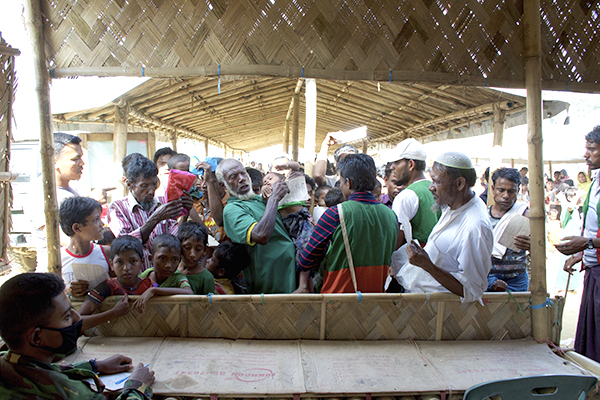Beyond Devastation: Suffering and Perseverance Among the Rohingya
20 October 2018
Cox’s Bazar, Bangladesh

The suffering of the Rohingya people in 2017 is beyond superlatives. The violence and brutality in the stories of those who have had opportunities to share are difficult to fathom, but as you hear one after another, they also become sadly repetitious. Masses of humanity have been uprooted from their villages in Burma, heaped into refugee camps in Bangladesh and awaiting an unknown fate. Once again, our ability to comprehend how one person suffers is overwhelmed by the scale on which the suffering is happening.
The oppression of the Rohingya people has been ongoing for years, but on August 25th, 2017, as tens of thousands of fleeing refugees turned into hundreds of thousands – it became an issue the world could no longer ignore. Displacement on this scale, happening so quickly, was an extraordinary event. The Burma Army conducted a near-eradication of Rohingya people from Burma with incredible efficiency as more than 600,000 people fled their homes in the space of three months. In the months following the initial attacks, that number would climb to 720,000 as people kept coming. The stories from the refugees paint a pretty clear picture: the Burma Army came in trucks, surrounded villages, shot indiscriminately, killing villagers as they fled and chasing them to neighboring Bangladesh. Then the soldiers burned the villages to the ground. Again and again. Satellite photos of burned villages corroborate these accounts.
Some of the difficulty in understanding what happened is because it happened so quickly, so quietly, and so efficiently. News agencies and aid groups could not get to where the Burma Army was attacking the Rohingya, so all the stories came in after the fact. And now in the aftermath, it’s tempting to think it’s too late to do anything about it; to think that, like a cancer that is too far progressed to treat, we can only watch in despair as a slow, painful end comes. As we stared at the Rohingya refugee camps in Bangladesh, now almost a year old and stretching as far as the eye can see, we felt this despair, felt a creeping resignation.

Five young Rohingya men were not resigned though. They were just getting started. With barely 10 days of FBR training under their belt, they had a few ranger skills and a full understanding that a ranger never surrenders. One coordinator and four rangers spent weeks trying to find a way back into Burma. The place their families and more than 700,000 people had just run away from, they were trying their best to get back to.
They wanted to see the scar that the Burma Army had left on their home and tell the world what that scar looks like. They wanted to help those who were still there. Most of all, they wanted to stand up and say, “This is our home. You can destroy our houses, kill our people, starve us, chase us – but you cannot stop us from claiming our home, you cannot stop us from loving and serving our people.”
And they did. They snuck across the border around Burma Army river patrols in the bottom of a boat in the middle of the night. They landed in the dark and hiked for hours in monsoon rains. They hid in the jungle, sneaking out to take photos and find the GPS points of villages that had been destroyed by the Burma Army, even as soldiers continued to occupy and patrol these areas. And they safely returned with this information to show the world.
The world is starting to know what happened. The West has belatedly slapped its forehead and begun increasing sanctions; the UN has labeled the actions of the Burma Army genocide, recommending the generals in charge of this operation be tried in the International Criminal Court. The world has done what it can do in the aftermath, but the truth is that we missed our chance to intervene before the Burma Army conducted this genocide. And, like using a bandaid on a cancer we did not catch in time, these measures seem too little, too late.
But these young men, these rangers, do not believe it is too late. They do not want to stand back and do nothing. They act with courage, pray with faith, and never surrender. And now they are planning and coordinating to head back in. They feel there is still a lot to do. There are still some Rohingya left over there that need help. These five young men want to go and provide that help and they know others who want to be trained in some ranger skills to also collect information and help. And that is how a movement spreads. Little acts of love, little glimpses of hope, a knowledge that they are not forgotten, and that God has a plan for them.
So maybe cancer is not the best analogy; maybe fire is. A wildfire can rage through a forest if not caught early. If ignored at the beginning it will soon grow too large to control. It will leave giant swaths of black – blackened trees, blackened ground, seemingly a lifeless landscape. But that ‘seemingly’ is important – for that is all it is. The seeds of life are buried deep and they often escape the fire and life will return. We see these seeds in our rangers. Their earth has been scorched – literally – but there is still life. Maybe it is buried, but it is enough to not despair.
Our rangers are pushing through the devastation. We are inspired to keep pushing with them and support them as they go.

